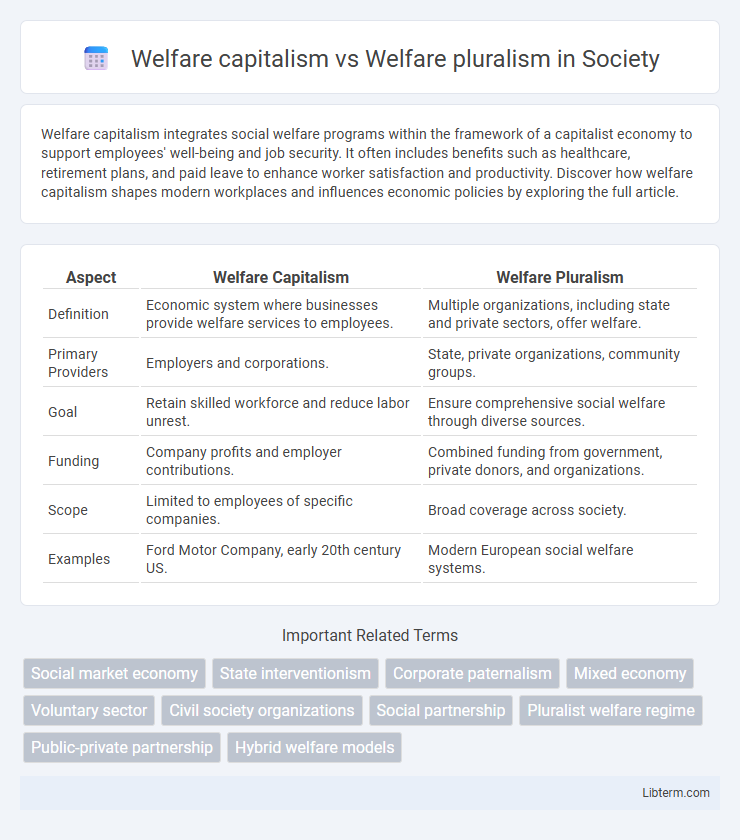Welfare capitalism integrates social welfare programs within the framework of a capitalist economy to support employees' well-being and job security. It often includes benefits such as healthcare, retirement plans, and paid leave to enhance worker satisfaction and productivity. Discover how welfare capitalism shapes modern workplaces and influences economic policies by exploring the full article.
Table of Comparison
| Aspect | Welfare Capitalism | Welfare Pluralism |
|---|---|---|
| Definition | Economic system where businesses provide welfare services to employees. | Multiple organizations, including state and private sectors, offer welfare. |
| Primary Providers | Employers and corporations. | State, private organizations, community groups. |
| Goal | Retain skilled workforce and reduce labor unrest. | Ensure comprehensive social welfare through diverse sources. |
| Funding | Company profits and employer contributions. | Combined funding from government, private donors, and organizations. |
| Scope | Limited to employees of specific companies. | Broad coverage across society. |
| Examples | Ford Motor Company, early 20th century US. | Modern European social welfare systems. |
Introduction to Welfare Capitalism and Welfare Pluralism
Welfare capitalism refers to a system where businesses provide social welfare services to employees, integrating social benefits such as healthcare, pensions, and housing directly into the workplace structure. In contrast, welfare pluralism emphasizes a diverse range of welfare providers, including state, market, voluntary organizations, and family units, sharing responsibility for social protection. This pluralistic approach promotes a decentralized welfare system that offers flexibility and acknowledges the varied needs of different social groups.
Historical Development of Welfare Models
Welfare capitalism emerged during the late 19th and early 20th centuries as industrialized nations sought to integrate social welfare provisions within capitalist economies, emphasizing employer responsibility for workers' benefits and social insurance. Welfare pluralism developed primarily after World War II, reflecting a diversification of welfare providers, including state, market, voluntary sectors, and families, accommodating growing complexity in social needs and institutional roles. The historical shift from welfare capitalism's employer-centered approach to welfare pluralism's multi-actor framework highlights evolving political and economic responses to social protection demands.
Defining Welfare Capitalism
Welfare capitalism is an economic system where businesses provide social welfare services to employees, such as healthcare and retirement benefits, to improve worker satisfaction and productivity. This model emphasizes corporate responsibility and direct employer involvement in social programs, contrasting with state-led welfare approaches. Welfare pluralism, on the other hand, involves multiple actors including government, private sector, and voluntary organizations sharing welfare provision responsibilities.
Defining Welfare Pluralism
Welfare pluralism defines a multifaceted approach to social welfare provision, emphasizing the coexistence of state, market, and voluntary sectors in delivering services. Unlike welfare capitalism, which centralizes welfare responsibilities within the government and employers, welfare pluralism recognizes the role of non-governmental organizations, community groups, and private entities in addressing social needs. This model promotes diversified welfare delivery, enhancing flexibility and responsiveness to social demands through multiple institutional actors.
Key Principles of Welfare Capitalism
Welfare capitalism centers on employer-provided social benefits and security measures designed to ensure worker loyalty and reduce labor unrest, emphasizing company responsibility in social welfare. Key principles include integrating welfare programs within corporate structures, promoting long-term employment stability, and aligning worker benefits with organizational productivity goals. This model contrasts with welfare pluralism, which advocates for multiple social welfare providers, including the state, private sector, and voluntary organizations.
Key Principles of Welfare Pluralism
Welfare pluralism emphasizes the collaboration between the state, market, and voluntary sectors in delivering social welfare, highlighting diversity and decentralization in service provision. It promotes choice, competition, and innovation by allowing multiple providers to address social needs, contrasting with welfare capitalism's state-centric and employer-based models. The key principles include shared responsibility, user empowerment, and the recognition of varied social actors contributing to welfare outcomes.
Comparative Analysis: State vs. Non-State Welfare Provision
Welfare capitalism primarily emphasizes state-led provision of social services funded and regulated by the government, ensuring standardized support across the population. In contrast, welfare pluralism advocates for a diversified approach where non-state actors such as private companies, charities, and community groups play a significant role in delivering welfare benefits alongside the government. Comparative analysis reveals that welfare capitalism offers centralized control and uniformity, while welfare pluralism provides flexibility and responsiveness through multiple providers, addressing varied social needs more dynamically.
Benefits and Criticisms of Welfare Capitalism
Welfare capitalism provides extensive employer-sponsored benefits such as health insurance, retirement plans, and paid leave, enhancing worker loyalty and productivity while aligning business interests with employee welfare. Critics argue that welfare capitalism may limit employee bargaining power, create dependency on employers, and reduce the role of government in ensuring social security. Unlike welfare pluralism, which involves multiple stakeholders including state, market, and community providers, welfare capitalism centralizes benefits within the corporate structure, potentially reducing social equity and coverage for non-employees.
Benefits and Criticisms of Welfare Pluralism
Welfare pluralism advocates for diverse providers including state, market, and voluntary sectors delivering social benefits, enhancing flexibility and responsiveness to varied social needs. It promotes competition and partnership among providers, potentially increasing innovation and efficiency in welfare provision while allowing tailored services for different populations. Critics argue that welfare pluralism may lead to inequality in access, fragmented service delivery, and reliance on market mechanisms that might undermine social solidarity and comprehensive protection.
Future Trends in Welfare Policy Models
Future trends in welfare policy models indicate a shift towards hybrid systems combining welfare capitalism's employer-driven social benefits with welfare pluralism's multi-actor approach involving state, market, and civil society. Innovations in digital technology and increased emphasis on participatory governance are expected to enhance the flexibility and responsiveness of welfare provision. Data from OECD countries reveal growing investments in personalized welfare services and collaborative policymaking as key drivers for sustainable and inclusive social protection systems.
Welfare capitalism Infographic

 libterm.com
libterm.com